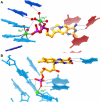The roles of metal ions in regulation by riboswitches
- PMID: 22010271
- PMCID: PMC3454353
- DOI: 10.1039/9781849732512-00141
The roles of metal ions in regulation by riboswitches
Abstract
Metal ions are required by all organisms in order to execute an array of essential molecular functions. They play a critical role in many catalytic mechanisms and structural properties. Proper homeostasis of ions is critical; levels that are aberrantly low or high are deleterious to cellular physiology. To maintain stable intracellular pools, metal ion-sensing regulatory (metalloregulatory) proteins couple metal ion concentration fluctuations with expression of genes encoding for cation transport or sequestration. However, these transcriptional-based regulatory strategies are not the only mechanisms by which organisms coordinate metal ions with gene expression. Intriguingly, a few classes of signal-responsive RNA elements have also been discovered to function as metalloregulatory agents. This suggests that RNA-based regulatory strategies can be precisely tuned to intracellular metal ion pools, functionally akin to metal-loregulatory proteins. In addition to these metal-sensing regulatory RNAs, there is a yet broader role for metal ions in directly assisting the structural integrity of other signal-responsive regulatory RNA elements. In this chapter, we discuss how the intimate physicochemical relationship between metal ions and nucleic acids is important for the structure and function of metal ion- and metabolite-sensing regulatory RNAs.
Figures




References
-
- Draper DE, Grilley D, Soto AM. Ions and RNA folding. Annu Rev Biophys Biomol Struct. 2005;34:221–243. - PubMed
-
- Misra VK, Shiman R, Draper DE. A thermodynamic framework for the magnesium-dependent folding of RNA. Biopolymers. 2003;69:118–36. - PubMed
-
- Sigel RK, Pyle AM. Alternative roles for metal ions in enzyme catalysis and the implications for ribozyme chemistry. Chem Rev. 2007;107:97–113. - PubMed
-
- Winkler WC, Breaker RR. Regulation of bacterial gene expression by riboswitches. Annu Rev Microbiol. 2005;59:487–517. - PubMed
Publication types
MeSH terms
Substances
Grants and funding
LinkOut - more resources
Full Text Sources
